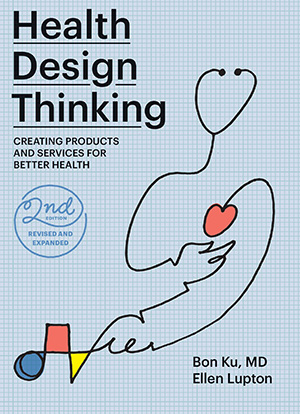
A review of
Health Design Thinking
MIT Press
228 pages, 26 chapters
About this book
by Bon Ku and Ellen Lupton
A good reference for Methods/How-To
Primary audience: Researchers, designers, and technical roles who have some or significant experience with the topic
Writing style: Matter of fact
Text density: Mostly text
Learn more about our book review guidelines
There are many books that discuss the challenges and issues related to how to fix our current healthcare system. These issues include rising costs (for medical procedures, hospital stays, and prescription drugs, etc.), limited access to care, workforce shortages, insufficient insurance coverage, budget constraints, and regulations, as well as current studies on infectious diseases and vaccines.
Health Design Thinking, by Bon Ku and Ellen Lupton, does not aim to fix the healthcare system, but rather it is a comprehensive hands-on, how-to guide about applying design thinking principles to build better healthcare products and services. The authors discuss how design thinking is a strategy designers can use to focus on real, everyday problems faced by providers, patients, and caregivers, rather than on healthcare technology or business issues.
The authors emphasize that design thinking is a strategy, a mindset that focuses on user needs, behaviors, and motivations. They describe its key features as being human-centered, iterative, creative, and collaborative, and they present it as an empathy-driven approach to designs that solve problems.
An illustration of how this design strategy is creative appears on page 34. It lists four principles that guide the process of developing ideas: questioning, visualizing, prototyping, and storytelling.
There are numerous case studies in the book that illustrate the application of health design thinking to products and services. Some of these include the design of hospital exam and patient rooms, wearable devices, drug packaging, and digital and home care products. Some of the UX methods highlighted by these case studies include role-playing, creating personas, storyboarding, and journey mapping.
Along with case studies, this book features a comprehensive list of health design challenges that readers can try. Some of these design challenges include observing healthcare providers to learn how they do their work, examining ways to improve the electronic health record, mapping a medical procedure journey, and making a prototype of a medical health app.
One of the takeaways from this book is that improving patient experience and healthcare relies heavily on collaboration among the clinicians, patients, and caregivers. Design thinking strategy provides a strong foundation to make design decisions and build solutions for better healthcare products and services.
Along with the many challenges facing the healthcare system today, there is consideration given to other health-related issues including an aging population, more patients wanting telehealth services, more need for home caregivers and assisted living facilities, and more treatment options for chronic conditions and infectious diseases (perhaps in light of the pandemic), as well as continued emphasis on wellness and fitness.
This book is a valuable resource to address collaboration and focus on everyone’s healthcare needs. This reference will inform designers and healthcare providers, including clinicians and their staff, caregivers, and patients. I highly recommend this book.
Health design thinking is an approach to generating creative ideas and solutions that enhance human well-being in the context of medicine. Health design thinking is an open mindset, rather than a rigid methodology. This emerging practice has been used to transform products, environments, workflows, and mission statements, and it brings new perspectives to medical professionals.
Karen Shor has worked as a Usability Specialist and Human Factors Engineer, managing the usability labs, conducting many usability tests, and working with product development teams and stakeholders to implement test findings to improve the user experience and help drive business strategy.


User Experience Magazine › Forums › Bridging UX and Healthcare Delivery (Book Review)